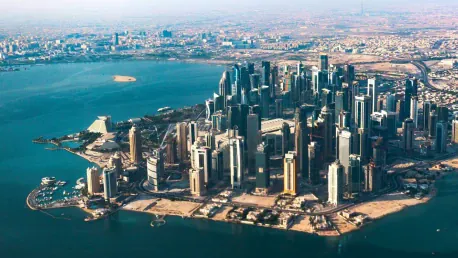Today, we are joined by Vladislav Zaimov, an experienced Telecommunications specialist well-versed in enterprise telecommunications and the risk management of vulnerable networks. We will discuss the recent Memorandum of Understanding (MoU) between Ericsson and Ooredoo Qatar, along with various aspects of their collaboration on 5G solutions.
Can you explain the main objectives behind the Memorandum of Understanding (MoU) between Ericsson and Ooredoo Qatar?
The main objectives behind the MoU between Ericsson and Ooredoo Qatar are to accelerate digital transformation efforts for enterprises and public sector entities in Qatar. This involves developing industry-specific 5G solutions and creating private and dedicated 5G networks for crucial sectors such as manufacturing, airports, and oil and gas. Both companies aim to enhance overall network performance, security, and quality of service through this partnership.
What prompted this partnership and why is it significant for both companies?
The partnership is driven by the growing need for digitalization and automation across various industries, which enhances efficiency, unlocks revenue potential, and fosters innovation. For both companies, this MoU is significant because it enables access to cutting-edge technology and expertise, facilitating the delivery of advanced use cases and mission-critical services that can boost their competitiveness in the region.
What industry-specific 5G solutions are being developed under this collaboration?
The industry-specific 5G solutions being developed include private and dedicated networks tailored for manufacturing, airports, and the oil and gas sector. These solutions aim to meet the unique needs of each sector, ensuring reliable network performance, enhanced security, and optimized quality of service through advanced technologies.
How will private and dedicated 5G networks benefit key sectors such as manufacturing, airports, and oil and gas in Qatar?
Private and dedicated 5G networks will significantly benefit these sectors by providing high-performance, secure, and resilient mobile broadband services. These networks support real-time data exchange and automation, improving operational efficiency, enabling autonomous operations, and ensuring mission-critical communications for public safety and other essential services.
Can you explain the role of a dual-mode core and advanced radio technologies in this partnership?
The dual-mode core and advanced radio technologies are crucial components of this partnership. They enable seamless integration of multiple networks, ensuring robust security, optimized quality of service, and high availability. These technologies support various applications, from day-to-day operations to mission-critical services, across different sectors.
What are the mission-critical solutions being introduced for public safety, digital airspace, and railway networks?
The mission-critical solutions introduced under this partnership include advanced communication systems designed for public safety, digital airspace management, and railway networks. These solutions ensure high availability, robust security, and optimized performance, which are essential for reliable and safe operations in these critical sectors.
How do you plan to leverage 5G technology to support sustainability and environmental initiatives?
5G technology will support sustainability and environmental initiatives by enabling more efficient operations, reducing energy consumption, and minimizing emissions. Through real-time monitoring and advanced analytics, industries can optimize their processes, reduce waste, and implement more sustainable practices, thereby contributing to a greener environment.
Can you provide specific examples of how 5G will help decarbonize industries in Qatar?
Specific examples include monitoring emissions in real-time, optimizing energy usage, and enabling remote operations that reduce the need for travel. For instance, in manufacturing, 5G can support smart grid applications that manage energy use better, while in the oil and gas sector, remote monitoring can reduce the carbon footprint associated with transportation and on-site inspections.
What will Ericsson contribute to this partnership in terms of technology and expertise?
Ericsson will contribute its advanced technology solutions, including Ericsson Private 5G and mission-critical network solutions. The company will provide access to its ecosystem partners, share global best practices, and offer insights from previous successful implementations, enhancing the overall technological and operational capabilities of the partnership.
How will Ooredoo Qatar benefit from Ericsson’s global best practices and insights?
Ooredoo Qatar will benefit significantly from Ericsson’s extensive experience and expertise. By leveraging Ericsson’s insights and best practices, Ooredoo can accelerate its digital transformation efforts, deploy state-of-the-art 5G solutions, and deliver high-performance services to its enterprise and public sector customers, driving growth and innovation in Qatar.
How will this partnership enhance efficiency and unlock revenue potential for enterprises in Qatar?
The partnership will enhance efficiency by providing advanced automation and digitalization solutions that streamline operations and reduce costs. It will unlock revenue potential through new 5G-enabled services and applications, such as autonomous vehicles, smart factories, and advanced IoT solutions, which can generate new business opportunities and drive economic growth.
Can you discuss some advanced use cases of 5G that will be implemented across different industries?
Advanced use cases include autonomous vehicles in logistics and transportation, smart manufacturing with real-time monitoring and automated processes, remote healthcare services, and enhanced public safety systems with real-time communication and data analytics. These use cases highlight the transformative potential of 5G across various sectors.
How does this partnership lay the foundation for future integration of 5G-Advanced (5G-A)?
The partnership establishes a robust infrastructure and technology base, enabling the seamless integration of 5G-A. It focuses on innovative features like interference reduction, outdoor positioning, and AI-driven RAN solutions to ensure superior connectivity in challenging environments. This foundation will facilitate the transition to even more advanced network capabilities in the future.
What key features will the new deployment of 5G-A include?
Key features of the new 5G-A deployment will include enhanced interference reduction techniques, outdoor positioning capabilities for better accuracy, and AI-driven RAN solutions to optimize network performance. These features will improve overall connectivity, reliability, and service quality, particularly in complex and high-demand environments.
Can you elaborate on the latest radio access network (RAN) and microwave backhaul solutions provided by Ericsson?
Ericsson’s latest RAN solutions include Massive MIMO radios that enhance capacity and coverage, while advanced microwave backhaul solutions, such as MINI-LINK with carrier aggregation, support high-capacity backhaul of up to 25 Gbps. These technologies improve network efficiency and expand coverage to areas where fiber is not available.
How will the deployment of Massive MIMO radios and advanced microwave solutions improve connectivity?
The deployment of Massive MIMO radios will increase network capacity and coverage, enhancing the user experience even in dense environments. Advanced microwave solutions will provide high-capacity backhaul, ensuring robust and reliable connectivity, particularly in remote areas. Together, these technologies will significantly improve overall network performance and user satisfaction.
What are the goals for expanding 5G coverage to remote areas in Qatar?
The goals for expanding 5G coverage to remote areas include providing robust and reliable connectivity, ensuring that high-quality network services are available even in the most isolated regions. This expansion aims to bridge the digital divide, support local communities, and enable economic development across the entire country.
How will the new 5G layer at 2.3 GHz spectrum and modernization of power systems impact network efficiency?
The new 5G layer at 2.3 GHz spectrum will enhance indoor and outdoor coverage and capacity, while the modernization of power systems will improve overall network efficiency by reducing energy consumption and operational costs. These advancements will lead to a more sustainable and cost-effective network infrastructure.
Do you have any advice for our readers?
My advice to readers is to stay informed about the latest technological advancements and consider how emerging technologies like 5G can be leveraged to improve efficiency, sustainability, and innovation within your respective industries. Embrace digital transformation and be open to new opportunities that can drive growth and success in the rapidly evolving digital landscape.









